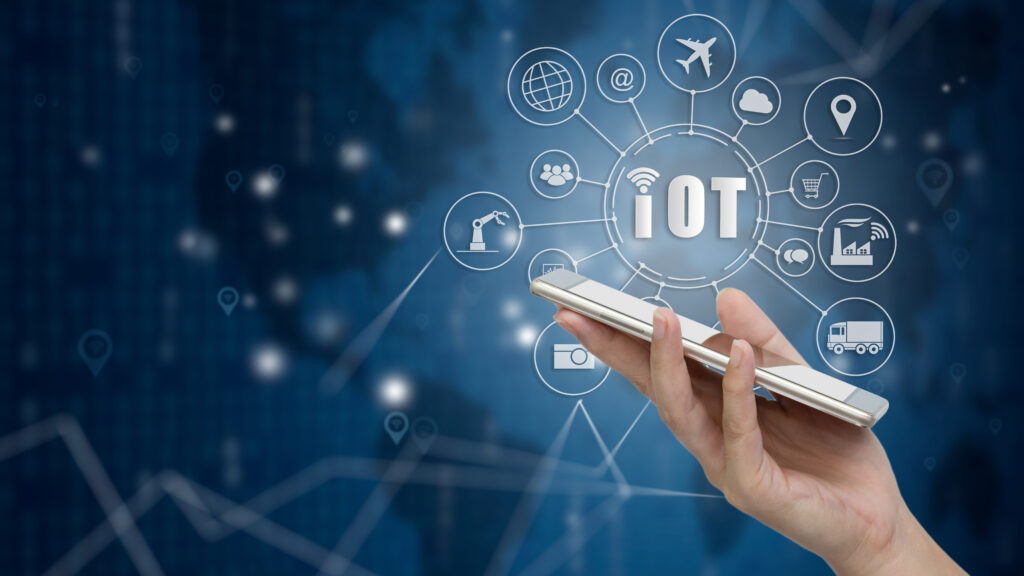Rising from the growing ubiquity of internet-connected devices, the surging Internet of Things presents novel trials in data management. As intelligent sensors permeate urban spaces and microchips inhabit household appliances, a ceaseless torrent of data pours forth. You contend with swelling data volume, velocity, and variety, striving to harness insights. With sound data architecture, robust analytics, and strategic planning, opportunities abound to extract value from this data deluge. Yet first, you must navigate the choppy waters of data capture, storage, integration, security, and analysis. In this piece, we explore the impacts of IoT on data management, equipping you with strategies to ride the waves.
The Explosion of IoT Devices Contributes to the Massive Influx of Data

The IoT Landscape
With billions of connected IoT devices in homes and businesses, the amount of data generated is exploding exponentially. IoT devices such as sensors, wearables, and smart home appliances generate data that provide critical insights. However, the massive influx of IoT data also challenges data management and deriving value.
Challenges of Managing IoT Data
IoT data’s variety, velocity, and volume require robust data management strategies. IoT data is often unstructured and comes in many forms, from device logs to sensor readings. This diversity and lack of standardization pose challenges for data integration and analysis.
The Need for Scalability
The colossal scale of IoT data demands scalable data management solutions. Traditional data management systems cannot cost-effectively handle the volume of IoT data. Cloud-based platforms and distributed data storage architectures are better suited to the demands of IoT data management.
Gaining Actionable Insights
To gain business value from IoT data, companies must implement analytics tools to derive actionable insights. Machine learning and predictive analytics can help uncover patterns and better understand IoT data. Insights from IoT data analysis enable data-driven decision-making and optimization of business processes.
With the right data management strategies and analytics in place, businesses can harness the potential of IoT data to optimize operations, uncover new revenue opportunities, and gain a competitive advantage. The challenges of managing and analyzing vast volumes of IoT data are surmountable with scalable and intelligent solutions. IoT data may be overwhelming in scale, but it contains valuable insights for innovation.
The Role of IoT Technologies in Big Data Management Systems
1. Massive Data Volumes from IoT
The Internet of Things has led to an explosion of connected devices that generate vast data. According to estimates, over 55 billion IoT devices will be produced by 2025, producing 79.4 zettabytes of data. This massive influx of IoT data brings significant collection, storage, and analysis challenges. Organizations must implement robust, extensive data management systems and scalable architectures to handle these enormous data volumes cost-effectively.
2. Challenges in Managing IoT Data
IoT data management poses unique difficulties due to the data’s variety, velocity, and variability. The data comes from diverse sources in different formats, is generated and collected rapidly, and the data rates and types constantly change.
Traditional data management systems struggle with the scale and diversity of IoT data. New big data technologies are needed to capture, store, and analyze IoT data to gain business insights.
3. Strategies for Harnessing the Value of IoT Data
Organizations should adopt strategies focused on connectivity, scalability, and actionability to leverage the potential value of IoT data. They need systems that can combine data from various IoT devices and sources. A scalable and flexible infrastructure is required to handle the data volumes cost-efficiently. Advanced analytics techniques are necessary to gain actionable insights from the raw data.
Companies can gain visibility into devices, assets, and operations using IoT data management platforms, predictive analytics, and machine learning. Organizations can optimize processes, reduce costs, and uncover new business opportunities by analyzing IoT data streams in near real-time. While IoT data brings significant challenges, those who can harness this data will gain a competitive advantage.
Challenges in Managing and Analysing IoT Data
The Volume of Data
The proliferation of connected IoT devices has led to an explosion in the volume of data generated. Billions of IoT sensors and devices produce massive amounts of data on a continuous basis. This huge volume of IoT data poses significant challenges for collection, storage, and analysis. Traditional data management techniques struggle to handle the massive scale of IoT data. New big data tools and architectures are required to store and process enormous data volumes.
The Variety of Data
IoT data comes in a wide variety of formats, from audio and video to text and sensor readings. This diversity of data types and formats, known as data variety, presents obstacles to analysis and value extraction. Integrating diverse data and deriving insights requires substantial data cleansing and normalization efforts. Powerful analytics tools are needed to handle the variety of IoT data.
The Velocity of Data
The speed at which IoT data is generated and flows into an organization is extremely high. This fast pace of data generation, known as data velocity, strains the ability to streamline data capture and analysis processes. Real-time analytics capabilities are necessary to keep up with the rapid velocity of IoT data and generate timely insights. Without real-time analytics, the value and relevance of IoT data can quickly perish.
Organizations require scalable infrastructure, innovative data management platforms, and real-time analytics tools to address these challenges. A well-designed IoT data management strategy helps harness the potential of IoT data despite the difficulties involved. With the proper data management approach and tools in place, the challenges of volume, variety, and velocity can be overcome to unlock the full potential of IoT data.
Strategies and Solutions for Effective IoT Data Management
Centralize data collection and storage.
With the proliferation of IoT devices comes an exponential increase in data volume, variety, and velocity. To manage this influx, a centralized data repository is essential. All data from IoT sensors and devices should be aggregated in a single system, such as a data lake or warehouse. This makes the data more accessible to access, analyze, and act upon to maximize its value.
Implement robust security measures.
IoT devices and the data they generate are vulnerable to cyber threats that can compromise privacy and security. Strict security controls, like data encryption, strong password policies, and user access management, must be implemented to safeguard IoT data and systems. Monitoring IoT networks and data for anomalies can also help detect potential attacks early.
Perform real-time analytics
The real-time nature of IoT data enables prompt analysis and action. Real-time analytics tools can detect anomalies, trends, and patterns as the data is streaming. This allows businesses to identify opportunities and threats quickly and make data-driven decisions immediately. However, the volume and velocity of IoT data can strain analytics platforms. Solutions like edge computing that perform analytics at the data source help alleviate this.
Develop data maintenance procedures.
While IoT data holds significant potential value, it must be appropriately maintained to realize that value. Developing standard operating procedures for data quality checking, integration, and governance is critical. These procedures ensure IoT data is accurate, consistent, and accessible for various use cases. They also aid compliance with data privacy regulations like GDPR.
Leverage AI and machine learning.
Artificial intelligence and machine learning are crucial for managing and extracting meaningful insights from massive IoT data—AI techniques like predictive analytics tap into IoT data to detect future opportunities, risks, and trends. Machine learning algorithms can also continually learn from IoT data, detecting increasingly complex patterns to optimize operations, predict maintenance needs, and personalize user experiences.
With comprehensive strategies for collecting, securing, analyzing, and maintaining IoT data, businesses can harness their full potential and open up new possibilities for digital innovation. The insights and intelligence gained from this data will ultimately drive digital transformation across industries.
The Power of IoT Data Management – Turning Data Into Actionable Insights
Harnessing IoT Data
- The Internet of Things has led to an explosion of connected devices that generate massive amounts of data. As IoT devices proliferate, the volume of data they produce grows exponentially. The key to deriving value from IoT is harnessing and turning this data into actionable insights. Organizations must implement robust data management strategies to collect, store, process, and analyze IoT data.
Storing and Securing Data
- IoT devices generate data at such a high velocity that storing it all can be difficult. Organizations need scalable solutions like cloud storage to collect IoT data. They must also ensure this data is secure by encrypting it and controlling access. With sensitive customer information at stake, security is paramount.
Extracting Insights
- Raw IoT data alone provides little value. Process, analyze, and turn the data into insights that can inform business decisions or trigger automated actions. Using techniques like predictive analytics, machine learning, and data visualization, organizations can detect patterns and trends in IoT data to optimize operations, improve products, and enhance customer experiences.
Integrating Data and Systems
- IoT data is most useful when integrated with other data sources like customer profiles, production statistics, or sales records. Integrating IoT systems with other IT systems provides a holistic, contextual understanding of the data. Open IoT platforms and interoperability standards make it easier to integrate data and systems.
Taking Action
- The ultimate goal of an effective IoT data management strategy is taking action based on insights. This could involve predictive maintenance of equipment, personalized customer engagements, optimized energy usage, or autonomous vehicle navigation. Putting insights into action is how organizations can achieve a return on their investment in IoT technology and data management solutions.
With a sound IoT data management strategy, organizations can overcome the challenges of storing, securing, and analyzing massive amounts of IoT data. By turning this data into actionable insights and value, organizations can stay ahead of the competition and maximize the promise of the IoT.
Key Takeaways..
As we have seen, the Internet of Things has led to an explosion of data that brings both opportunities and challenges. With careful planning, strong data governance, and the right analytical tools, organizations can harness the power of IoT data to gain valuable insights that drive innovation. By implementing robust data management strategies and making data-driven decisions, you can position your organization to thrive in the era of the Internet of Things. The key is to start now – develop a clear roadmap, invest in skills and technology, and focus on extracting meaning from the wealth of data streaming from IoT devices. Those who effectively manage this new data deluge will gain a competitive edge. With the guidance provided here, you now have the key considerations to start your IoT data journey.
More Stories
Hitachi Empowers Real-Time Data Integration with EverFlex AI Data Hub
In today’s data-driven world, Hitachi Vantara’s EverFlex AI Data Hub becomes a crucial tool for real-time data integration.
Minimal-Data Optimization for Search Agent Training in RAG Systems
In the fast-changing world of RAG systems, training search agents with minimal-data optimization is a key challenge.
AI-Driven Data Governance: Snowflake’s Strategic Investment in Theom
Demands for strong governance frameworks is rising; Snowflake’s support of Theom highlights importance of integrating AI-native platforms.
Snapchat Brings Messaging Power to the Apple Watch
In an era where connectivity is king, Snapchat takes a pioneering leap by bringing its dynamic messaging capabilities to the...
Sisense Intelligence: Transforming Data into Action with Generative AI
Sisense Intelligence offers a seamless experience, allowing you to interact with data using natural language and generate insightful dashboards without the need for complex coding.
Perplexity Labs: Transforming Prompts into Dynamic Reports and Dashboards
As a professional in today’s fast-changing digital world, you need tools that go beyond traditional limitations. That’s where Perplexity Labs comes in—an innovative feature from Perplexity AI, available only to Pro subscribers. It turns your creative prompts into detailed reports, interactive dashboards, spreadsheets, and even full web applications.


